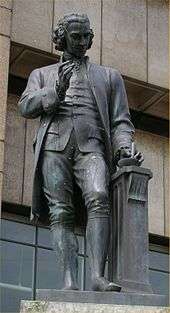Francis John Williamson
| Francis John Williamson | |
|---|---|
|
The sculptors's bust of Queen Victoria | |
| Born |
17 July 1833 Hampstead, London, England |
| Died |
12 March 1920 (aged 86) Esher, Surrey, England |
| Residence | Fairholme, 79 High Street, Esher, Surrey, England |
| Nationality | British |
| Occupation | Sculptor |
Francis John Williamson (17 July 1833[1] – 12 March 1920[1]) was a British portrait sculptor,[2] reputed to have been Queen Victoria's favourite.[3]
Career
After studying under John Bell he was an articled pupil of John Henry Foley for seven years, and his studio assistant for a further fourteen.[1]
Williamson exhibited with the Royal Academy of Arts 38 times from 1853–1897.[1] and with the Royal Birmingham Society of Artists in 1868, when he showed several items, including a medallion depicting Mrs W. Wills, 1887 and 1902.[1] It was during his time with Foley that he first met Victoria.[1] In 1870, she commissioned a memorial to George IV's daughter Princess Charlotte and her husband Prince Leopold (Victoria's uncle) which was erected inside their former home, Claremont.[1][4] (The memorial was subsequently moved to St George's Church, Esher.[4]) Many members of the royal family subsequently sat for him,[1] and in 1887 he sculpted the (Golden) Jubilee bust of Queen Victoria, which was replicated for display around the British Empire.[1]
Williamson received a number of commissions from the municipal authorities in Birmingham. These included a marble bust of the Shakespearian scholar Samuel Timmins,[2] now in the Library of Birmingham, a statue of the dissenting theologian and natural philosopher Joseph Priestley, now in Chamberlain Square,[2] a statue of Sir Josiah Mason, (destroyed, but a 1952 bronze cast of the bust, by William Bloye, is in the suburb of Erdington), a statue of preacher and reformer George Dawson (since destroyed), a statue of John Skirrow Wright (also destroyed; a 1956 bronze cast of the bust by Bloye is in Birmingham Council House), and the decoration on the pediment of the Birmingham Museum and Art Gallery, a work known as the Allegory of Fame Rewarding the Arts.[2] A plaster cast of his bust of Tennyson (1893) is in the National Portrait Gallery.[5]
He met his future wife, Elizabeth Smith, while staying in Esher and they married in 1857[5] In 1860, they set up a home and him a studio at Fairholme, 79, High Street, Esher,[3][6] where he eventually died.[5] The building (later named "The Bunch of Grapes" and now "Grapes House"[5]) is extant,[3] and carries a blue plaque, erected by the Esher Residents Association in 2010, in commemoration of Williamson.[5]
His younger brother John Henry Williamson (born c. 1843) was a silversmith.[1]
List of selected works

- Bust of Samuel Timmins, now in the Library of Birmingham
- Statue of Sister Dora, Walsall
- Memorial to Prince Leopold and Princess Charlotte, now at St George's Church, Esher, Surrey
- Memorial Bust of the Duke of Albany, Christ Church, Esher
- Diamond Jubilee Memorial, Esher
- Tomb of William Brett, 1st Viscount Esher and Viscountess Esher, Christ Church churchyard, Esher
- The Shrubsole Memorial, Market Place, Kingston upon Thames
- Bust of Lord Tennyson
- Queen Victoria, bust, many copies
- Hypatia
- His Royal Highness Prince Edward of York
- Monument to James Young Gibson in Dean Cemetery, Edinburgh (1887)
- Jesus as the Good Shepherd
- Allegory of Fame Rewarding the Arts, Pediment, Birmingham Museum and Art Gallery (1884)[2]
- a statue of Sir Josiah Mason (1885; destroyed)[2]
- bronze cast of the bust, by William Bloye (1952)[2]
- statue of George Dawson (1885; destroyed)[2]
- bronze cast of bust, by Bloye (1951; stolen, presumed scrapped)[2]
- statue of John Skirrow Wright (1883; destroyed)[2]
- bronze cast of bust, by Bloye (1956)[2]
- Joseph Priestley statue, now in Chamberlain Square, Birmingham (Bronze, cast in 1951 from marble original of 1874)[2]
- Memorial to Dean Milman, St Paul's Cathedral[2]
See also
- George Phoenix, collaborator
References
- 1 2 3 4 5 6 7 8 9 10 "Francis John Williamson". 2013. Retrieved 29 August 2013.
- 1 2 3 4 5 6 7 8 9 10 11 12 13 Noszlopy, George T. (24 April 1998). Public Sculpture of Birmingham. Liverpool University Press. ISBN 0853236925.
- 1 2 3 "Francis John Williamson (1833–1920)". The Victorian Web. Retrieved 29 August 2013.
- 1 2 "Memorial to Prince Leopold and Princess Charlotte". The Victorian Web. Retrieved 29 August 2013.
- 1 2 3 4 5 "Esher Residents Association Blue Plaque Scheme – Current Status". Esher Residents Association. Retrieved 3 September 2013.
- ↑ Coordinates: 51°22′08″N 0°21′57″W / 51.368769°N 0.365781°W
External links
| Wikimedia Commons has media related to Francis John Williamson. |
